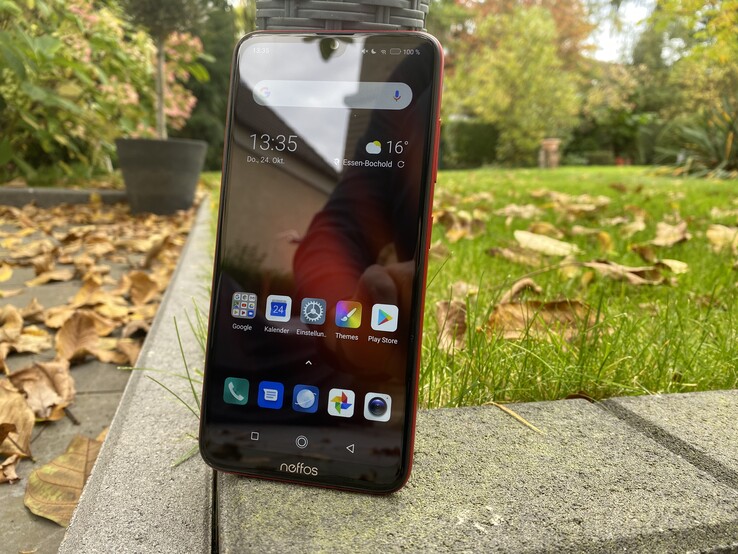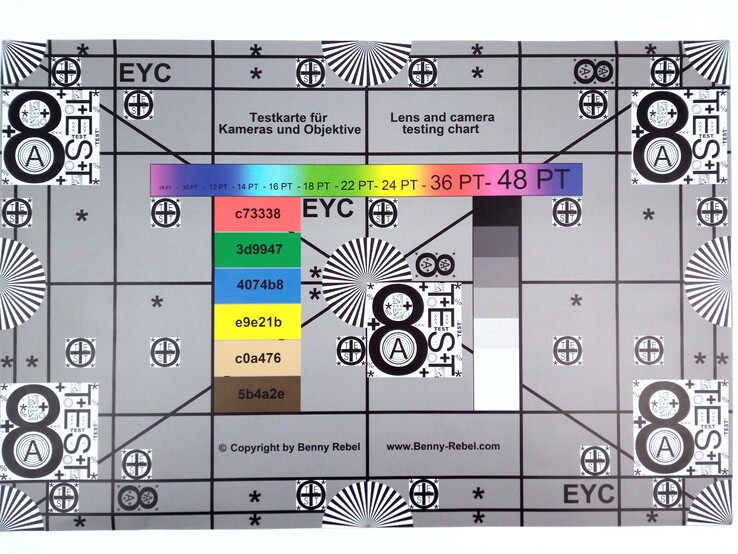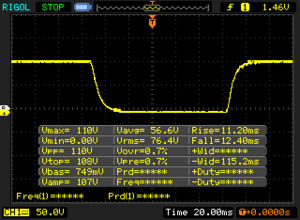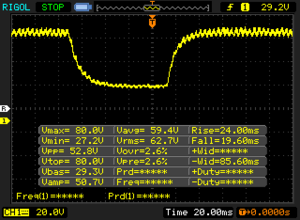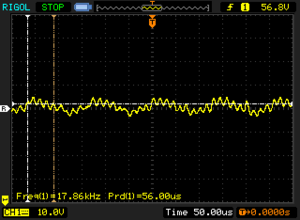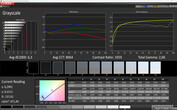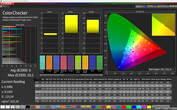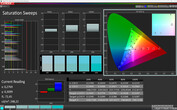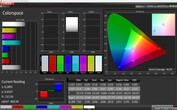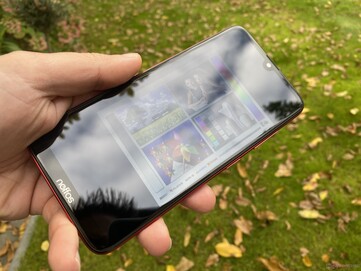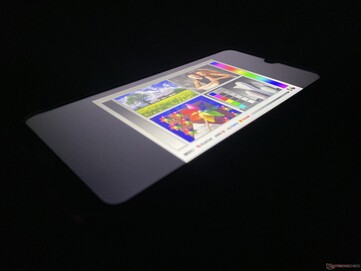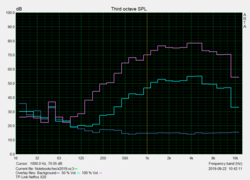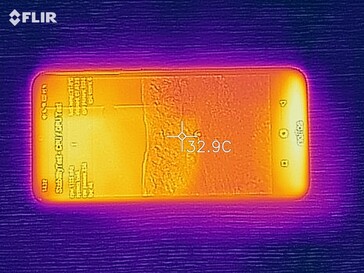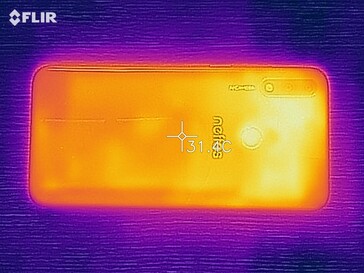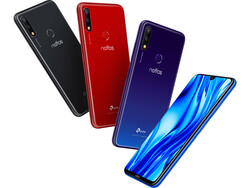Review TP-Link Neffos X20: Cheap smartphone with long battery life
Comparison units
Rating | Date | Model | Weight | Drive | Size | Resolution | Price |
|---|---|---|---|---|---|---|---|
| 73.8 % v7 (old) | 10 / 2019 | TP-Link Neffos X20 Helio A22 MT6761, PowerVR GE8300 | 171 g | 32 GB eMMC Flash | 6.26" | 1520x720 | |
| 75.5 % v7 (old) | 07 / 2019 | Samsung Galaxy A20e Exynos 7884B, Mali-G71 MP2 | 141 g | 32 GB eMMC Flash | 5.80" | 1560x720 | |
| 72.8 % v7 (old) | 06 / 2019 | Huawei Y5 2019 Helio A22 MT6761, PowerVR GE8300 | 146 g | 16 GB eMMC Flash | 5.71" | 1520x720 | |
| 78.8 % v6 (old) | 06 / 2019 | Nokia 3.2 SD 429, Adreno 504 | 181 g | 16 GB eMMC Flash | 6.26" | 1520x720 |
Case, equipment and operation
The Neffos X20 is available in the colours Aurora Purple, Black, Red and Blue and fits well in the hand. The quality of workmanship and choice of materials is on a good level, our red test device also looks good, although the back is quite susceptible to fingerprints. The battery is firmly installed, there is no IP certification.
The Micro-USB port now looks a bit old-fashioned, but supports USB-OTG. A memory expansion using a microSD card is possible, but the exFAT file system is not supported. After all, a full dual SIM solution is offered. There is also an audio jack and an analogue radio receiver.
The software used is Google Android 9.0 Pie, whose security updates are as of April 5, 2019 at the time of testing and are therefore no longer up-to-date. Regular updates are certainly not the case here.
At best, the Neffos X20 gets into the mobile Internet with LTE, the frequency coverage is limited to the regionally common bands. The reception was inconspicuous in the test and the Neffos delivers a decent call quality in everyday life. It also supports VoLTE, but no WLAN calling. The WLAN is very fast and stable in view of the price class.
The operation as such gives no cause for criticism, only by the weak SoC short waiting times arise again and again. The fingerprint sensor on the SoC recognizes our finger very reliably in the test. Face recognition is also offered, which is a bit faster, but also less secure.
| Networking | |
| iperf3 transmit AX12 | |
| TP-Link Neffos X20 | |
| Huawei Y5 2019 | |
| Nokia 3.2 | |
| Samsung Galaxy A20e | |
| iperf3 receive AX12 | |
| TP-Link Neffos X20 | |
| Huawei Y5 2019 | |
| Samsung Galaxy A20e | |
| Nokia 3.2 | |
Cameras - Dual camera in the Neffos X20
The Neffos X20's dual camera offers neither an ultra wide angle nor a telephoto zoom, the second lens only collects depth information for Bokeh mode. The quality is good, but compared to top models it shows weaknesses in dynamic range and tends to be overexposed in bright image areas. The shutter release delay is also quite slow and the start of the camera takes almost two seconds.

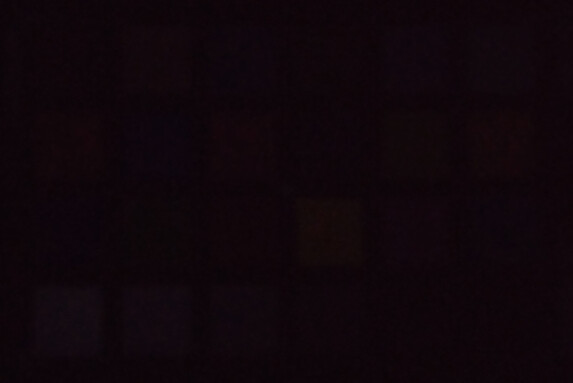
Display - Neffos with low-contrast panel
The Neffos X20's 6.26 inch (15.90 cm, 97.81 cm²) display turns out to be a solid panel with sufficient brightness. Only in the APL50 test (347 cd/m²) does it weaken a little, which underlines the impression of the somewhat too weak contrast (APL50: 667:1) in everyday life. Positive: the supposed PWM is rather a high-frequency flicker, so no problems are to be expected.
The color reproduction shows visible deviations, but no falsifications and is on a level usual in the class.
| |||||||||||||||||||||||||
Brightness Distribution: 93 %
Center on Battery: 470 cd/m²
Contrast: 1146:1 (Black: 0.41 cd/m²)
ΔE ColorChecker Calman: 6 | ∀{0.5-29.43 Ø4.78}
ΔE Greyscale Calman: 6.3 | ∀{0.09-98 Ø5}
94.2% sRGB (Calman 2D)
Gamma: 2.06
CCT: 8064 K
| TP-Link Neffos X20 1520x720, 6.3" | Samsung Galaxy A20e 1560x720, 5.8" | Huawei Y5 2019 1520x720, 5.7" | Nokia 3.2 1520x720, 6.3" | |
|---|---|---|---|---|
| Response Times | 5% | 36% | -1% | |
| Response Time Grey 50% / Grey 80% * (ms) | 43.6 ? | 44.4 ? -2% | 30 ? 31% | 40 ? 8% |
| Response Time Black / White * (ms) | 23.6 ? | 20.8 ? 12% | 14 ? 41% | 26 ? -10% |
| PWM Frequency (Hz) | 17860 ? | 349.7 ? | 1000 ? | 1866 ? |
| Screen | -6% | -3% | -8% | |
| Brightness middle (cd/m²) | 470 | 475 1% | 630 34% | 415 -12% |
| Brightness (cd/m²) | 455 | 473 4% | 593 30% | 391 -14% |
| Brightness Distribution (%) | 93 | 93 0% | 88 -5% | 86 -8% |
| Black Level * (cd/m²) | 0.41 | 0.35 15% | 0.66 -61% | 0.55 -34% |
| Contrast (:1) | 1146 | 1357 18% | 955 -17% | 755 -34% |
| Colorchecker dE 2000 * | 6 | 6.8 -13% | 5.79 3% | 4.8 20% |
| Colorchecker dE 2000 max. * | 10.1 | 13.4 -33% | 9.54 6% | 9.51 6% |
| Greyscale dE 2000 * | 6.3 | 8.7 -38% | 7 -11% | 5.7 10% |
| Gamma | 2.06 107% | 2.33 94% | 2.176 101% | 2.255 98% |
| CCT | 8064 81% | 9385 69% | 8420 77% | 7824 83% |
| Total Average (Program / Settings) | -1% /
-4% | 17% /
5% | -5% /
-7% |
* ... smaller is better
Display Response Times
| ↔ Response Time Black to White | ||
|---|---|---|
| 23.6 ms ... rise ↗ and fall ↘ combined | ↗ 11.2 ms rise | |
| ↘ 12.4 ms fall | ||
| The screen shows good response rates in our tests, but may be too slow for competitive gamers. In comparison, all tested devices range from 0.1 (minimum) to 240 (maximum) ms. » 53 % of all devices are better. This means that the measured response time is worse than the average of all tested devices (20.2 ms). | ||
| ↔ Response Time 50% Grey to 80% Grey | ||
| 43.6 ms ... rise ↗ and fall ↘ combined | ↗ 24 ms rise | |
| ↘ 19.6 ms fall | ||
| The screen shows slow response rates in our tests and will be unsatisfactory for gamers. In comparison, all tested devices range from 0.165 (minimum) to 636 (maximum) ms. » 72 % of all devices are better. This means that the measured response time is worse than the average of all tested devices (31.6 ms). | ||
Screen Flickering / PWM (Pulse-Width Modulation)
| Screen flickering / PWM detected | 17860 Hz | ≤ 100 % brightness setting | |
The display backlight flickers at 17860 Hz (worst case, e.g., utilizing PWM) Flickering detected at a brightness setting of 100 % and below. There should be no flickering or PWM above this brightness setting. The frequency of 17860 Hz is quite high, so most users sensitive to PWM should not notice any flickering. In comparison: 53 % of all tested devices do not use PWM to dim the display. If PWM was detected, an average of 8098 (minimum: 5 - maximum: 343500) Hz was measured. | |||
Performance, emissions and battery life
The TP-Link Neffos X20 is driven by a MediaTek Helio A22, which is located at the lowest end of the performance spectrum. This is not only noticeable in the benchmarks, but also in everyday life, because small pauses for thought are the rule, there is no room for elaborate 3D games.
The surface temperatures are almost identical in idle as well as under load and always remain pleasantly low.
The loudspeaker of the X20 at the lower edge delivers a solid sound output, which completely misses the low mids, but delivers a good sound image at medium volume. If you turn up the phone fully, you'll only get a distorted sound delivered to your ear. Alternatively, an audio jack or Bluetooth 5.0 is available. The latter even supports aptX and aptX HD.
The battery life is on a good level with over eleven hours in the practical WLAN test, even though the Neffos smartphone is the last in the comparison field. We positively noticed the low consumption values in standby in the test. Even after more than a week without use, the battery was still over 60 percent full.
| PCMark for Android - Work 2.0 performance score (sort by value) | |
| TP-Link Neffos X20 | |
| Samsung Galaxy A20e | |
| Huawei Y5 2019 | |
| Nokia 3.2 | |
| Average Mediatek Helio A22 MT6761 (4195 - 5511, n=11) | |
| GFXBench 3.0 | |
| on screen Manhattan Onscreen OGL (sort by value) | |
| TP-Link Neffos X20 | |
| Samsung Galaxy A20e | |
| Huawei Y5 2019 | |
| Nokia 3.2 | |
| Average Mediatek Helio A22 MT6761 (11 - 15, n=7) | |
| Average of class Smartphone (18 - 166, n=157, last 2 years) | |
| 1920x1080 1080p Manhattan Offscreen (sort by value) | |
| TP-Link Neffos X20 | |
| Samsung Galaxy A20e | |
| Huawei Y5 2019 | |
| Nokia 3.2 | |
| Average Mediatek Helio A22 MT6761 (6.5 - 7.3, n=7) | |
| Average of class Smartphone (12 - 606, n=156, last 2 years) | |
| GFXBench 3.1 | |
| on screen Manhattan ES 3.1 Onscreen (sort by value) | |
| TP-Link Neffos X20 | |
| Samsung Galaxy A20e | |
| Huawei Y5 2019 | |
| Nokia 3.2 | |
| Average Mediatek Helio A22 MT6761 (7.6 - 11, n=7) | |
| Average of class Smartphone (11 - 166, n=157, last 2 years) | |
| 1920x1080 Manhattan ES 3.1 Offscreen (sort by value) | |
| TP-Link Neffos X20 | |
| Samsung Galaxy A20e | |
| Huawei Y5 2019 | |
| Nokia 3.2 | |
| Average Mediatek Helio A22 MT6761 (2.5 - 5, n=7) | |
| Average of class Smartphone (8.4 - 413, n=156, last 2 years) | |
| TP-Link Neffos X20 | Samsung Galaxy A20e | Huawei Y5 2019 | Nokia 3.2 | Average 32 GB eMMC Flash | Average of class Smartphone | |
|---|---|---|---|---|---|---|
| AndroBench 3-5 | 29% | 9% | 20% | 23% | 1778% | |
| Sequential Read 256KB (MB/s) | 279 | 300.4 8% | 272.1 -2% | 282.4 1% | 242 ? -13% | 2228 ? 699% |
| Sequential Write 256KB (MB/s) | 90.6 | 103.6 14% | 45.2 -50% | 106.3 17% | 100.5 ? 11% | 1852 ? 1944% |
| Random Read 4KB (MB/s) | 39.39 | 79.8 103% | 62.1 58% | 35 -11% | 43.1 ? 9% | 296 ? 651% |
| Random Write 4KB (MB/s) | 8.65 | 13.18 52% | 13.1 51% | 17.5 102% | 22.3 ? 158% | 339 ? 3819% |
| Sequential Read 256KB SDCard (MB/s) | 82.6 ? | 79.2 ? -4% | 81.8 ? -1% | 87.2 ? 6% | 71.8 ? -13% | |
| Sequential Write 256KB SDCard (MB/s) | 63 ? | 64.3 ? 2% | 63.1 ? 0% | 65.7 ? 4% | 52.9 ? -16% |
Temperature
(+) The maximum temperature on the upper side is 31.9 °C / 89 F, compared to the average of 35.2 °C / 95 F, ranging from 21.9 to 247 °C for the class Smartphone.
(+) The bottom heats up to a maximum of 32.1 °C / 90 F, compared to the average of 34 °C / 93 F
(+) In idle usage, the average temperature for the upper side is 30.1 °C / 86 F, compared to the device average of 32.9 °C / 91 F.
Loudspeakers
TP-Link Neffos X20 audio analysis
(+) | speakers can play relatively loud (86.6 dB)
Bass 100 - 315 Hz
(-) | nearly no bass - on average 30.5% lower than median
(±) | linearity of bass is average (8.5% delta to prev. frequency)
Mids 400 - 2000 Hz
(+) | balanced mids - only 4.9% away from median
(±) | linearity of mids is average (7% delta to prev. frequency)
Highs 2 - 16 kHz
(+) | balanced highs - only 4.6% away from median
(+) | highs are linear (3.2% delta to prev. frequency)
Overall 100 - 16.000 Hz
(±) | linearity of overall sound is average (21.2% difference to median)
Compared to same class
» 40% of all tested devices in this class were better, 8% similar, 52% worse
» The best had a delta of 11%, average was 35%, worst was 134%
Compared to all devices tested
» 58% of all tested devices were better, 7% similar, 35% worse
» The best had a delta of 4%, average was 24%, worst was 134%
Samsung Galaxy A20e audio analysis
(±) | speaker loudness is average but good (81.6 dB)
Bass 100 - 315 Hz
(-) | nearly no bass - on average 27.1% lower than median
(±) | linearity of bass is average (9.4% delta to prev. frequency)
Mids 400 - 2000 Hz
(±) | reduced mids - on average 5.8% lower than median
(+) | mids are linear (5.4% delta to prev. frequency)
Highs 2 - 16 kHz
(±) | higher highs - on average 5.7% higher than median
(+) | highs are linear (2.5% delta to prev. frequency)
Overall 100 - 16.000 Hz
(±) | linearity of overall sound is average (24% difference to median)
Compared to same class
» 55% of all tested devices in this class were better, 8% similar, 37% worse
» The best had a delta of 11%, average was 35%, worst was 134%
Compared to all devices tested
» 71% of all tested devices were better, 6% similar, 22% worse
» The best had a delta of 4%, average was 24%, worst was 134%
Battery life
| Battery Runtime - WiFi Websurfing | |
| Average of class Smartphone (12.1 - 54.1, n=209, last 2 years) | |
| Nokia 3.2 | |
| Samsung Galaxy A20e | |
| Huawei Y5 2019 | |
| TP-Link Neffos X20 | |
Pros
Cons
Verdict - Long runtimes and good audio properties
The TP-Link-Neffos X20 is a solid entry-level smartphone with a stylish look and good battery life. It also features an audio jack, analogue radio reception and even Bluetooth 5.0 with aptX HD. The latter is certainly a rarity in this price range. Just as positive, if you want to use Dual-SIM (2x Nano), you don't have to do without a microSD card.
The camera delivers rather moderate results, which are sufficient for simple social media needs, but quickly reaches its limits in low light. However, it offers many setting options and shooting modes.
The Neffos X20 is a colourful beginner's smartphone that convinces above all with its battery life.
Although the display is pleasantly large, it delivers a weak contrast ratio in everyday life. Outside, the panel is quickly overwhelmed. The system performance is quite slow, but this is no different for most competitors in this price range.
The smartphone is particularly suitable for occasional users who prefer to use their mobile phone for writing messages and otherwise leave it lying around more often. Especially the latter will be pleased that the battery only empties very slowly, especially in standby mode.
TP-Link Neffos X20
- 10/25/2019 v7 (old)
Daniel Schmidt




